The old gods of war: rare artillery in the Syrian war
Under the conditions of the current war, artillery is of particular importance, which in this case fully justifies its nickname “god of war”. All parties to the conflict use those or other tools, including artisanal manufacturing. In the case of government troops, there is a fairly widespread use of old weapons, including during the Second World War. Old artillery is used for a number of reasons. Home - the loss of a new weapons or development of its resource. In addition, some old guns still have high firepower, which is capable of ensuring the performance of combat missions even in the conditions of a modern conflict.
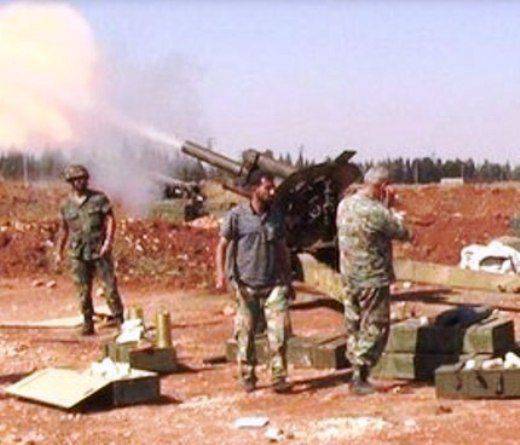
Syrian gunners firing at the enemy. Photo Vestnik-rm.ru
According to reports, the total number of artillery shells in the Syrian army may exceed 3 thousand units. It should be noted that the number of different weapons and equipment is constantly changing. During the fighting, the army loses guns and armored vehicles and suffers other casualties. In addition, the successful completion of some operations allows you to replenish the fleet of vehicles with trophies. It is possible that part of the weapons and equipment during the war managed to change the owners several times. For this reason, an accurate count of the number of certain systems is not possible.
Howitzer D-30
The 122-mm howitzer D-30 is a fairly old, although not completely outdated model of artillery of the Syrian army. According to The Military Balance 2014 and other sources, the Syrian armed forces had 450 guns of this type. Four hundred howitzers are used in the towed version, about fifty more are mounted on self-propelled chassis. To increase the mobility of artillery on the battlefield, these guns were mounted on a medium chassis tanks T-34-85 Soviet production.
The design of the D-30 gun howitzer makes it possible to fire with different elevation angles, attacking targets both in direct fire and from closed positions. It is possible to use separate loading projectiles of several types. By changing the angle of elevation and the use of various missile charges, the calculation of the weapon can fire at targets at distances over 15 km. Such characteristics of the D-30 howitzers can be used in most war operations.
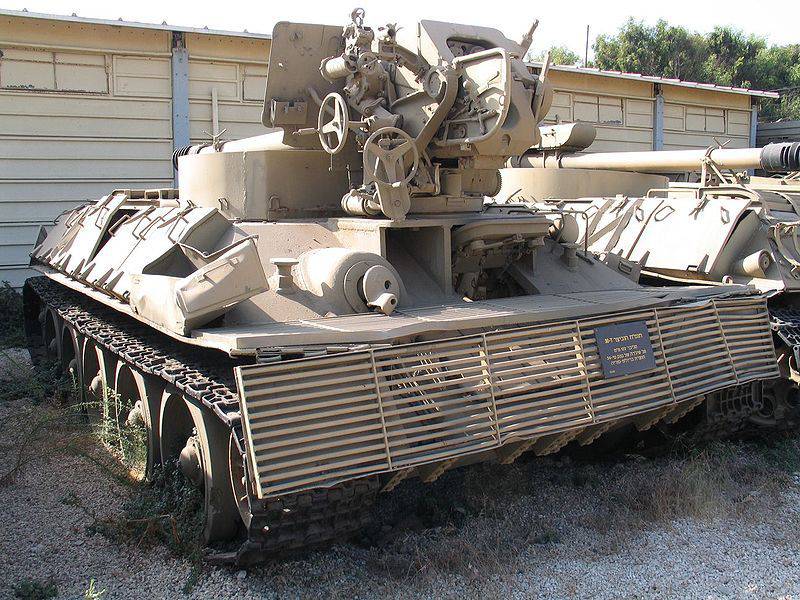
Syrian self-propelled gun based on the T-34 tank and D-30 howitzer, which became the trophy of the Israeli army. Photo Alternathistory.org.ua
Howitzer D-30 was adopted by the Soviet army in the early sixties. In the future, guns of this type were supplied to third countries, including Syria. In total, the Syrian military received at least such 550-600 howitzers. Since that time, a part of these tools was probably written off as a result of the development of a resource. In addition, a number was destroyed or became the enemy's trophy during the civil war. To date, the total number of D-30 in the Syrian army does not exceed 400-450 units.
C-23 gun
A real rarity is the 180-mm C-23 gun, which is in service with the Syrian army. This tool was created by Soviet designers in the fifties, but did not become widespread. In the mid-fifties, shortly after the Soviet Army was adopted, only a few such guns were built, after which production stopped. New C-23 left the conveyor only in the late sixties (according to other data, after 1970), and, as far as we know, they were already produced for export deliveries, including to Syria
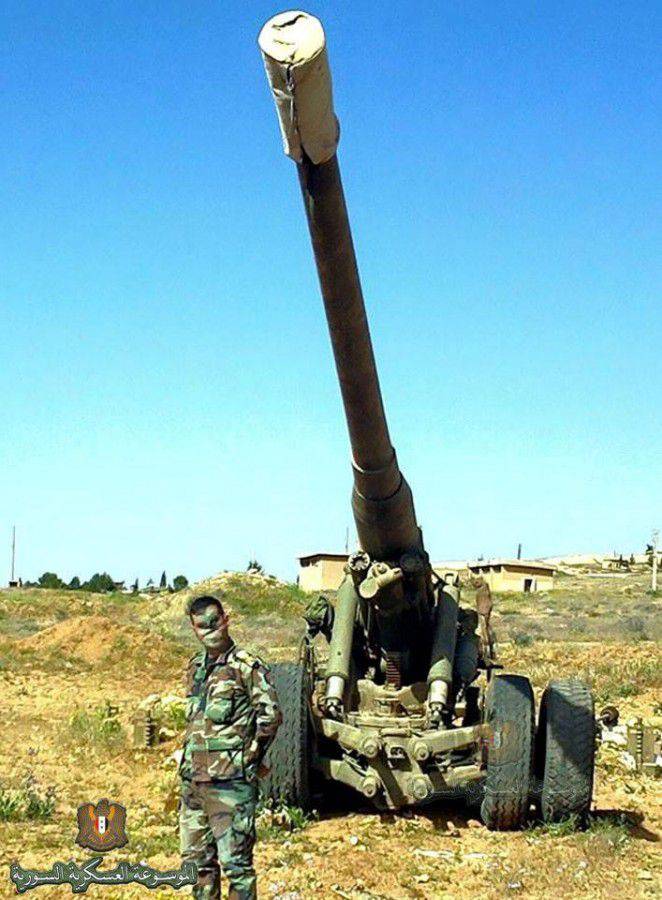
Fighter of the Syrian army and the gun C-23. Photo Imp-navigator.livejournal.com
The C-23 towed gun has a total weight of more than 21 t and is serviced by the calculation of 16 people. For delivery on the battlefield, the gun needs a tractor with the appropriate characteristics. The main ammunition guns are high-explosive shells caliber 180 mm. In addition, the use of concrete and other projectiles, including nuclear ones, is possible. When using a fragmentation projectile, the maximum firing range reaches 30,4 km. Due to the relatively large weight of ammunition and the lack of automation of reloading, the C-23 can fire at a rate of no more than one shot per minute. With long-term shooting, the rate of fire drops by half: the calculation takes about two minutes to prepare for a shot.
According to available information, no more than 10-12 C-23 type guns were delivered to Syria. The Military Balance 2014 reference book mentions 10 units of such weapons. Later sources, such as photographs from Syrian soldiers, suggest using at least six guns. Video on the use of such weapons against the so-called. moderate opposition or terrorist organizations are missing. However, there is reason to believe that C-23 is one of the means to destroy the militants. This, in particular, contributes to the long range and relatively high power of ammunition.
Howitzer M-30
Some types of artillery weapons, developed in the thirties of the last century, were produced serially and after the end of World War II. One example of this is the 122-mm howitzer of the 1938 sample of the year, also known as M-30. The first serial M-30 were handed over to the troops in 1940, and the last were released in 1955. In the postwar period, the rate of production declined significantly. Thus, during the war, no less than 2600 howitzers per year were produced (1945), and in the fifties, annual production volumes rarely exceeded 100 units. After the completion of serial production of M-30 howitzers, the Soviet industry began producing more advanced D-30.
The 122-mm howitzer of the 1938 model is considered to be one of the most successful Russian guns from the Great Patriotic War. Armament of this type was actively used in various operations, which was promoted by its rather high characteristics and a large number of usable ammunition. Using fragmentation, shrapnel and other projectiles, M-30 could attack targets at ranges up to 11,8 km. In the postwar period, the range of ammunition was replenished with several new products, which expanded the range of tasks to be solved.
In the post-war period, M-30 howitzers, both existing and new, were actively supplied to third countries. At least one and a half hundred such guns were transferred to the Syrian armed forces. There is reason to believe that during the past few years such weapons remained in storage and were not used by the troops, since the information about their quantity remained unchanged from year to year. However, over the past few months, a number of photographic and video materials have appeared indicating the use of M-30 in combat.
For obvious reasons, howitzers developed in the late thirties, in terms of characteristics, are inferior to newer systems of similar caliber, not to mention more powerful tools. Nevertheless, seven decades ago, the M-30 gun demonstrated its potential, and now it clearly shows that it is still capable of solving the set combat missions.
Howitzer ML-20
Another rarity in the artillery formations of Syria is the 152-mm howitzer-gun of the 1937 model, or the ML-20. Like the M-30, these howitzers were developed in the second half of the thirties and were intended to re-equip the Red Army before the oncoming war. From 1937 to 1946, the Soviet industry built and transferred almost 6900 howitzer ML-20 to the army in towed form. In addition, almost 4 thousand such guns were made to arm self-propelled artillery installations.
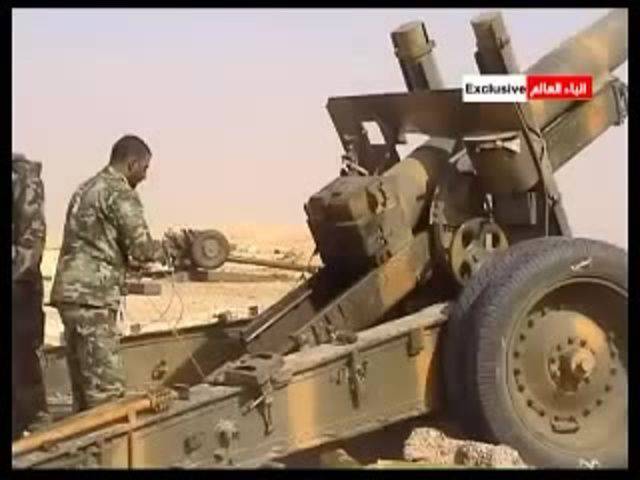
Preparations for howitzer shooting ML-20. The D-30 is visible in the background.
The howitzer cannon ML-20 is deservedly considered one of the best tools of the Soviet development. In addition, there are more flattering assessments, making it the list of the best guns of the whole world for all history. The appearance of such assessments contributed to the high performance and combat effectiveness of the gun. The gun ML-20 is capable of firing direct fire or from a closed position. In the latter case, it is possible to hit targets at ranges up to 17,2 km. Moreover, in the post-war period, an active-missile projectile was developed, the firing range of which exceeded 20 km. In total, the range of ammunition guns includes shells of nearly four dozen types.
Due to the high power of propelling charges and 152-mm howitzer-cannon shells obr. 1937 had and has a high combat effectiveness in the destruction of open and fortified positions of the enemy. In addition, there are known cases of destruction of enemy armored vehicles with high-explosive fragmentation projectiles. In such cases, the destruction of the target was ensured only by the kinetic energy of the munition.
According to available data, at present, the Syrian army has no more than 70 howitzers ML-20 and similar systems D-20 of later release. Syrian artillerymen are aware of the high effectiveness of such weapons, and therefore they actively use them to fire at enemy positions. ML-20 and D-20 appear regularly in photos and videos from the front.
Howitzer 10.5 cm leFH 18
It should be noted, not only the Syrian army has "antique" weapons. The opposing groups and organizations, being in a similar position, are also forced to use artillery, whose age has exceeded several decades. For example, back in 2012, it became known that 105-mm 10.5 cm leFH 18 German-made XNUMX-mm howitzer fell into the hands of one of the groups opposing government forces.
The 105-mm lightweight howitzer was developed in the late twenties, but only went into series in the middle of the next decade. In the future, the 10.5 gun cm leFH 18 passed several upgrades, which allowed him to remain in mass production and maintain the status of the main howitzer of its class in the Wehrmacht. In view of the upgraded versions in 1935-45, German enterprises built more than 7 thousand of similar howitzers. All these weapons were actively used by Nazi Germany until the very end of the war.
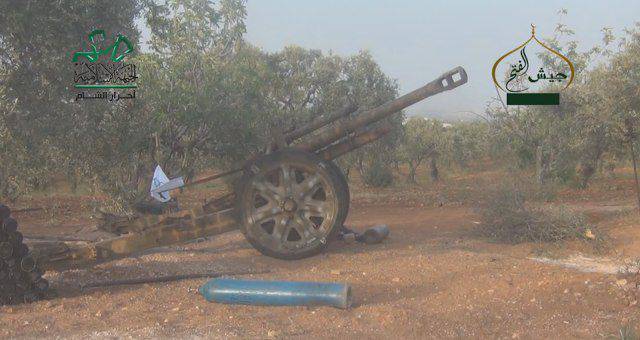
Former German howitzer 10.5 cm leFH18, used by one of the armed formations
The main objective of 10.5 howitzer cm leFH 18 was the shelling of remote objects of the enemy using high-explosive fragmentation shells weighing 14,8 kg. In addition, in view of the specifics of the Second World War, an armor-piercing shell was created. In the future, the range of ammunition replenished with several new shots. When firing from a closed position, when using a fragmentation projectile and a corresponding sleeve with a propelling charge, targets were hit at ranges up to 10,67 km.
According to reports, after the end of World War II, most of the German guns, including 10.5 howitzers cm leFH 18, passed on to other countries. A number of 105-mm light howitzers went to Czechoslovakia, where they were used for several decades. Subsequently, the “used” weapon was transferred to Syria, where it was also operated for some time. Later, Syrian howitzers went to the storage bases, where they remained until the start of the war. In the 2011-12 years, some of the storage bases were captured by the militants, thanks to which they were able to replenish their arsenals, as well as to begin operation of the old German howitzers. During the war, part of the 10.5 guns cm leFH 18 was destroyed in battle, changed owners or was abandoned to develop a resource.
***
Local conflicts of recent years, including the war in Syria, have several characteristic features. One of them is the use of a variety of weapons produced in different countries at different times. In addition, weapons made by belligerents in artisanal conditions are also actively used. This feature of the conflict attracts the attention of specialists and amateurs of military affairs, and also demonstrates the ingenuity and resourcefulness of armies and groups that find themselves in difficult conditions.
The reasons for the use of old and artisanal weapons systems are simple and clear. Not all parties to the current conflict can count on anyone's help in the required amounts. As a result, it is necessary to remove outdated equipment or weapons from storage, as well as to make new weapons on their own. In addition, the use of outdated weapons contributes to the lack of a developed defense industry in Syria and a solid age of weapons and equipment in the arsenals. In other words, those systems that have long since become obsolete from the point of view of developed armies, in the case of the Syrian army or armed formations, are quite modern and suitable for use.
It is also necessary to take into account the peculiarities of the conflict. The existing conditions do not impose any special requirements on weapons and equipment that the old models do not fundamentally correspond to. This is especially pronounced in the case of artillery. The guns and howitzers in the Syrian war only require a certain range of fire, acceptable accuracy and power of ammunition, as well as the ability to quickly get out of return fire. Artillery systems from the Second World War and newer models fully comply with such requirements. In addition, the parties to the conflict simply have no choice.
The Syrian army does not have to choose, and the allies are not able to supply it with a large number of modern artillery guns. As a result, in the artillery divisions of Syria there is a real "assorted" from a large number of types of guns. Practice shows that such a weapon, despite its age, is quite capable of attacking the enemy and destroying it. It should be noted that the use of weapons of various types from different eras also demonstrates the fact that the Syrian army is doing everything possible to combat terrorism and preserve statehood, not paying attention to the age of the materiel and other insignificant things in this situation.
On the materials of the sites:
http://lenta.ru/
http://vestnik-rm.ru/
http://russianarms.ru/
http://alternathistory.org.ua/
http://shurupo-vert.ru/
http://bmpd.livejournal.com/
http://imp-navigator.livejournal.com/
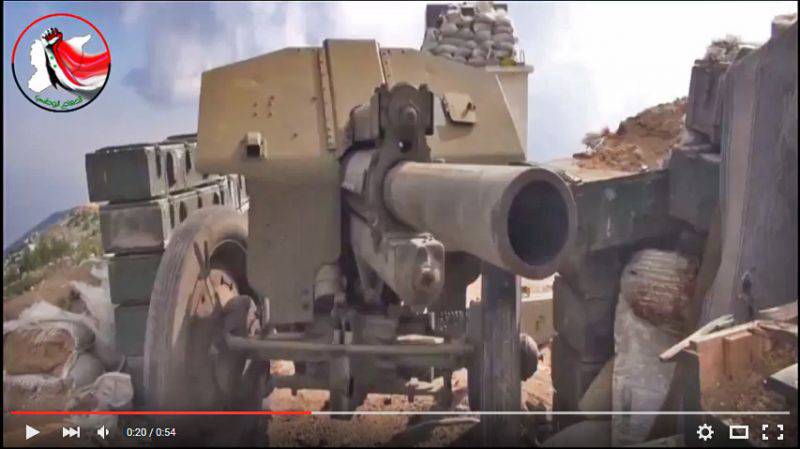
Information